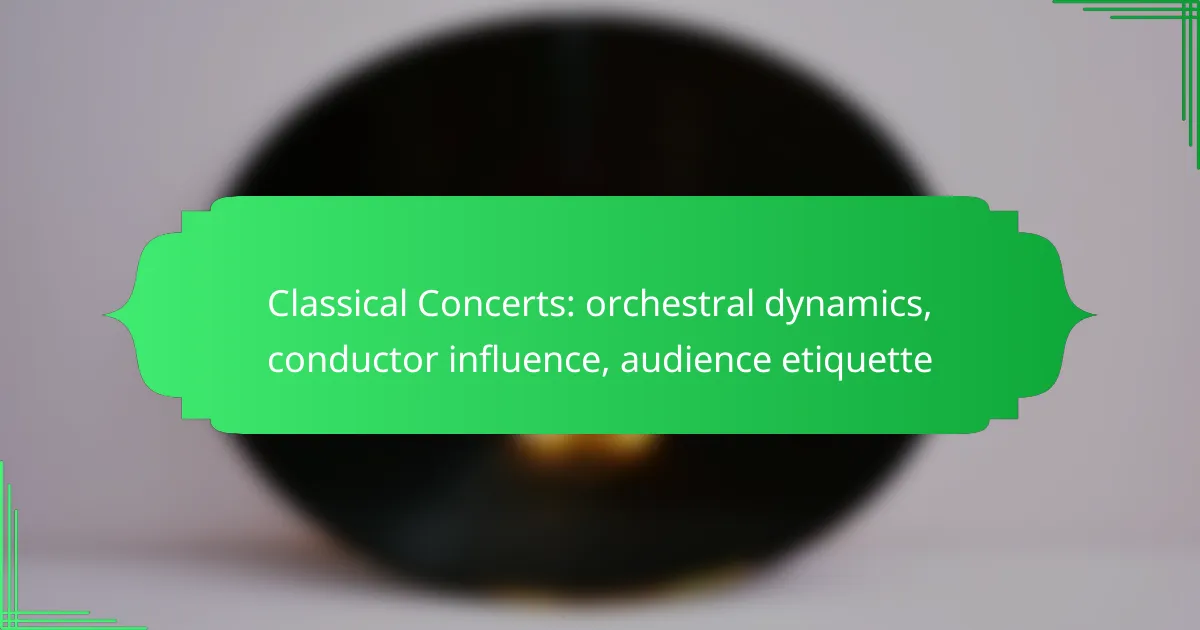Classical concerts offer a unique auditory experience, where orchestral dynamics create a rich tapestry of sound that captivates the audience. The conductor’s influence is pivotal, shaping the interpretation and emotional expression of the music, while audience etiquette plays a vital role in maintaining an atmosphere of respect and attentiveness. Together, these elements contribute to an immersive and memorable musical journey.
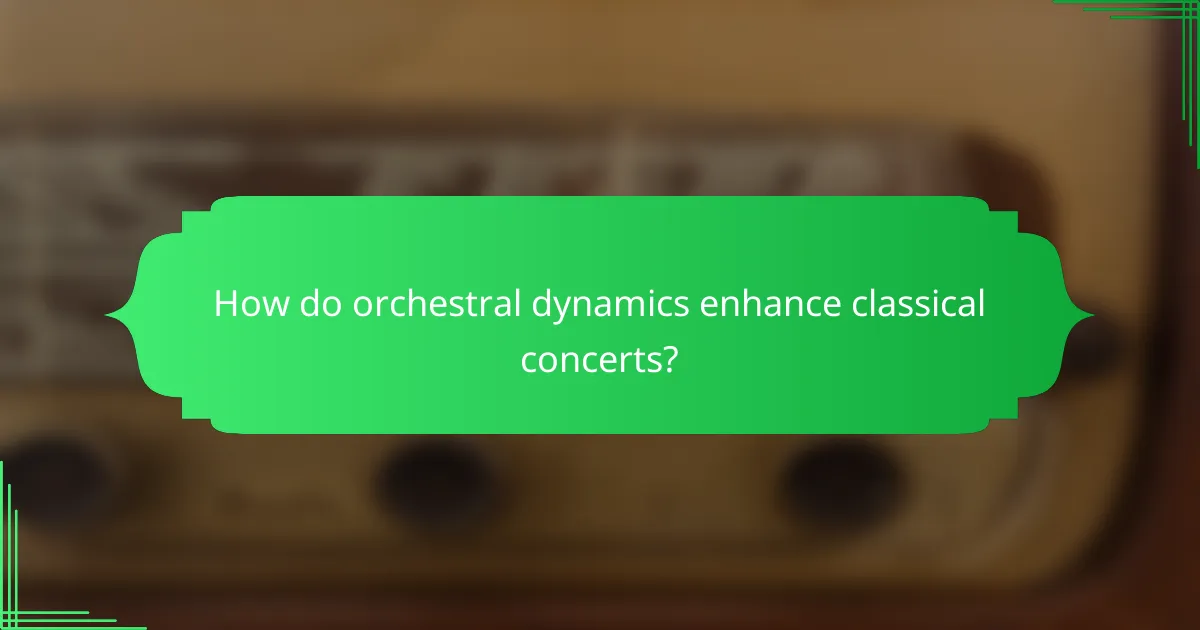
How do orchestral dynamics enhance classical concerts?
Orchestral dynamics play a crucial role in enhancing classical concerts by creating a rich tapestry of sound that engages the audience. The variations in volume, intensity, and texture help convey emotions and narratives within the music, making the experience more immersive.
Role of instrumentation
The choice of instruments significantly influences orchestral dynamics. Each instrument has a unique timbre and range, contributing to the overall sound. For example, strings often provide warmth and depth, while brass can add brightness and power, allowing for a diverse sonic palette.
Additionally, the arrangement of instruments within the orchestra affects how dynamics are perceived. A well-balanced orchestration ensures that softer passages are heard clearly, while louder sections can create dramatic contrasts that captivate the audience.
Impact of dynamics on audience experience
Dynamics directly shape the audience’s emotional response during a concert. Soft passages can evoke feelings of intimacy and reflection, while powerful crescendos can generate excitement and awe. This ebb and flow of sound keeps listeners engaged and invested in the performance.
Moreover, the conductor’s interpretation of dynamics can enhance this experience. By emphasizing certain dynamic contrasts, conductors guide the audience’s emotional journey, making each performance unique and memorable.
Examples from major orchestras
Major orchestras around the world, such as the Berlin Philharmonic and the New York Philharmonic, showcase the importance of dynamics in their performances. These orchestras often highlight dynamic contrasts in their interpretations of classical works, allowing audiences to experience the full emotional range of the music.
For instance, during a performance of Beethoven’s Symphony No. 9, the dramatic shifts between soft and loud passages can leave a lasting impression on the audience. Such examples illustrate how orchestral dynamics are not just technical elements but vital components of the concert experience.
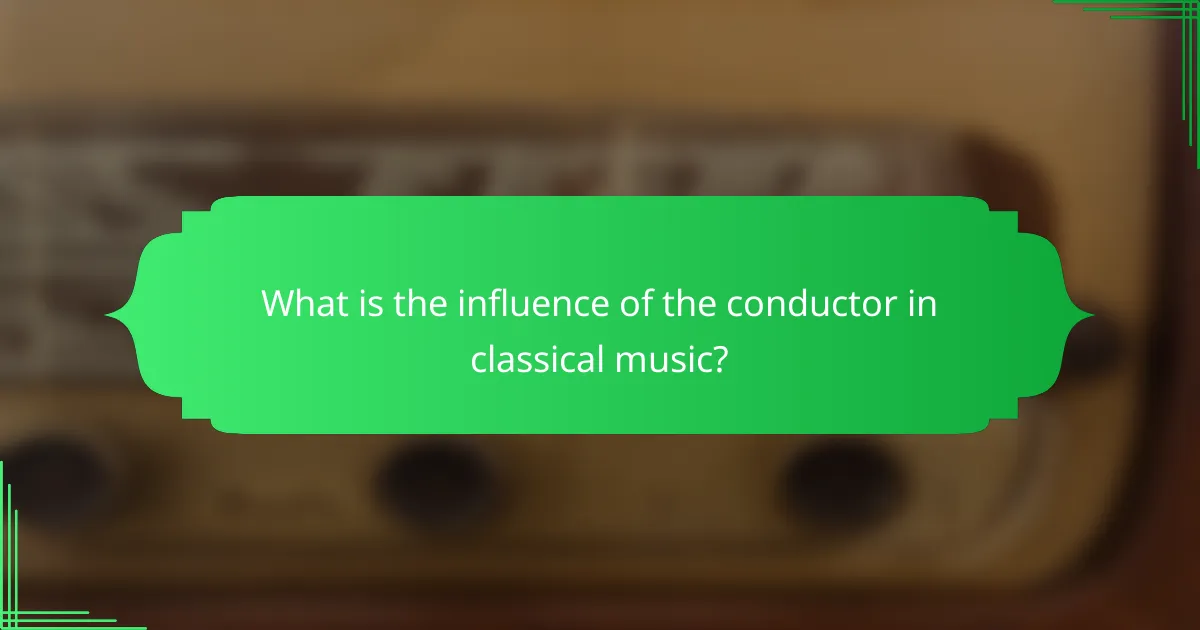
What is the influence of the conductor in classical music?
The conductor plays a crucial role in classical music by shaping the interpretation and performance of orchestral works. Their influence extends to tempo, dynamics, and the overall emotional expression of the music, guiding the orchestra to achieve a cohesive sound.
Conductor’s role in orchestral interpretation
The conductor’s primary responsibility is to interpret the score and communicate their vision to the orchestra. This involves making decisions about tempo, dynamics, and phrasing, which can significantly alter the piece’s character. A conductor’s interpretation can lead to varied performances of the same composition, showcasing different emotional depths and nuances.
Effective communication is essential; conductors use gestures, facial expressions, and body language to convey their intentions. This non-verbal communication helps musicians understand the conductor’s interpretation, ensuring a unified performance.
Famous conductors and their styles
Many renowned conductors have left a lasting impact on classical music through their distinct styles. For instance, Leonard Bernstein was known for his passionate and expressive conducting, often bringing a theatrical flair to performances. In contrast, Herbert von Karajan was celebrated for his precision and clarity, emphasizing the orchestral texture.
Other notable conductors include Gustavo Dudamel, who infuses energy and enthusiasm into performances, and Marin Alsop, recognized for her innovative approaches and commitment to contemporary works. Each conductor’s unique style influences how orchestras interpret and present classical pieces.
Case studies of conductor impact
One notable case is the interpretation of Beethoven’s symphonies. Conductors like Simon Rattle have approached these works with a focus on historical performance practices, resulting in a sound that reflects the composer’s intentions more closely. This contrasts with more traditional interpretations that may emphasize romanticism.
Another example is the impact of Gustavo Dudamel on the Los Angeles Philharmonic, where his dynamic conducting style has revitalized the orchestra’s performances, attracting new audiences and enhancing engagement with contemporary repertoire. Such case studies illustrate how a conductor’s influence can reshape an orchestra’s identity and audience perception.

What are the expected audience etiquettes at classical concerts in Canada?
At classical concerts in Canada, audience members are expected to maintain a respectful and attentive demeanor. This includes refraining from talking, using electronic devices, and ensuring that personal noise is minimized to enhance the experience for everyone.
Common etiquette rules
Common etiquette rules at classical concerts include arriving on time, remaining quiet during performances, and only applauding at appropriate moments, typically after a complete piece. It’s advisable to turn off or silence mobile phones and other devices to avoid distractions.
Dress codes can vary, but many attendees opt for semi-formal to formal attire, reflecting the concert’s ambiance. Bringing a program can enhance understanding, but avoid rustling papers during the performance.
Differences in etiquette across venues
Etiquette can differ significantly between venues in Canada. For instance, larger concert halls may have a more formal atmosphere, while smaller, community-based venues might be more relaxed in their expectations. It’s essential to observe the crowd and follow their lead.
Some venues may have specific rules regarding photography or recording, so checking the venue’s guidelines beforehand can prevent misunderstandings. Additionally, certain events may encourage more audience interaction, such as casual Q&A sessions with the conductor or musicians.
Importance of audience behavior
Audience behavior plays a crucial role in the overall concert experience. Respectful conduct not only enhances individual enjoyment but also supports the performers by allowing them to focus on their music without distractions. A well-behaved audience contributes to a positive atmosphere.
Moreover, proper etiquette fosters a sense of community among attendees, creating a shared appreciation for the art form. When everyone adheres to these guidelines, it elevates the concert experience for all involved, ensuring that the focus remains on the music.
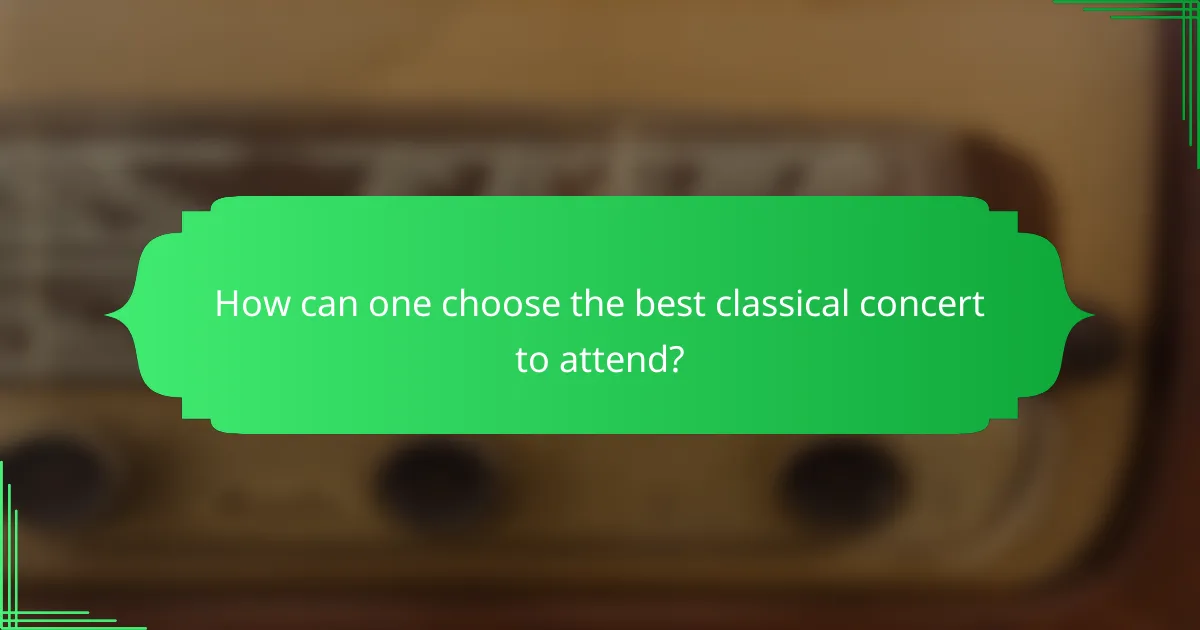
How can one choose the best classical concert to attend?
Choosing the best classical concert involves considering factors like the repertoire, the conductor, and the venue. Researching upcoming performances and understanding your personal preferences will help you select an event that resonates with you.
Factors to consider when selecting a concert
When selecting a classical concert, consider the type of music being performed, the reputation of the orchestra, and the conductor’s style. Different conductors bring unique interpretations to the same piece, which can greatly influence your experience.
Additionally, think about the concert’s location and the venue’s acoustics. A well-designed hall can enhance the sound quality, making the performance more enjoyable. Check if the venue offers comfortable seating and good sightlines to ensure a pleasant experience.
Popular venues in Canada
Canada boasts several renowned venues for classical music. The Toronto Symphony Orchestra performs at Roy Thomson Hall, known for its excellent acoustics and vibrant atmosphere. The National Arts Centre in Ottawa is another prominent location, hosting a variety of orchestral performances throughout the year.
Other notable venues include the Orpheum Theatre in Vancouver and the Montreal Symphony Orchestra’s Maison symphonique. Each venue has its unique charm and character, contributing to the overall concert experience.
Upcoming events and festivals
To find upcoming classical concerts, check local listings and websites dedicated to music events. Major cities often host annual festivals, such as the Vancouver International Film Festival and the Toronto Summer Music Festival, which feature orchestral performances.
Keep an eye on seasonal concert series, as many orchestras have regular performances throughout the year. Subscribing to newsletters from your favorite orchestras can also keep you informed about special events and ticket sales.
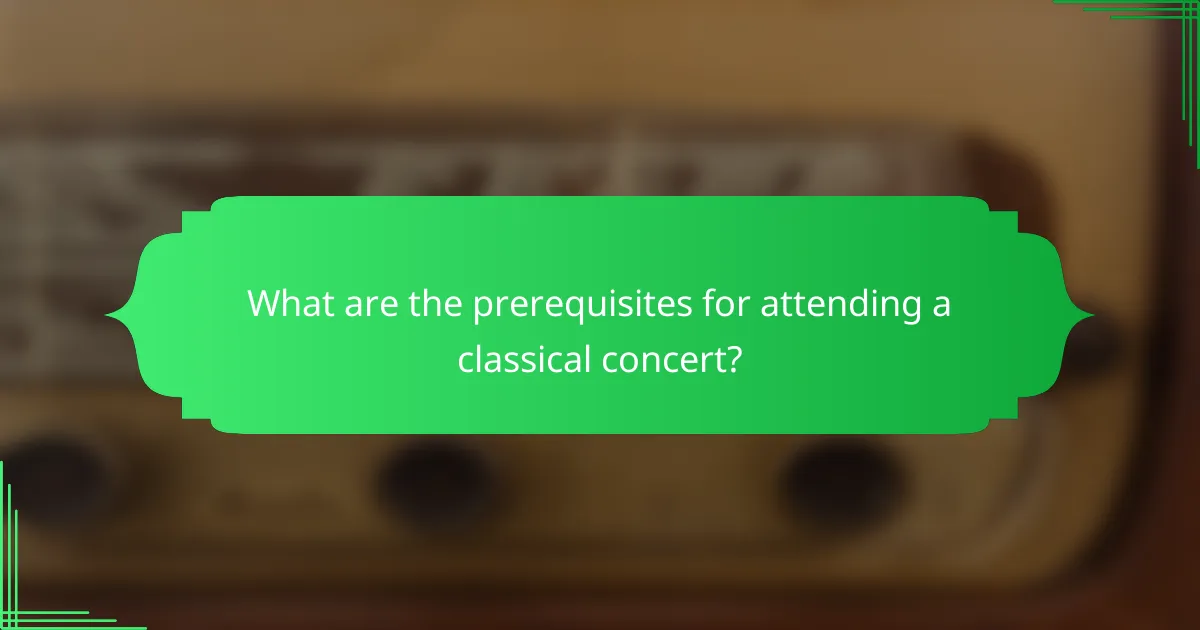
What are the prerequisites for attending a classical concert?
To attend a classical concert, familiarize yourself with the concert program, understand the orchestral works being performed, and prepare adequately if it’s your first time. These steps will enhance your experience and appreciation of the performance.
Understanding concert programs
Concert programs provide essential information about the pieces being performed, including the composers, the order of the pieces, and any relevant notes. They often include background on the works and the performers, which can enrich your understanding and enjoyment.
Take the time to read the program before the concert begins. This will help you follow along and appreciate the nuances of each piece, as well as the overall theme of the concert.
Familiarity with orchestral works
Having a basic knowledge of the orchestral works being performed can significantly enhance your concert experience. Familiarize yourself with popular composers like Beethoven, Mozart, and Tchaikovsky, and listen to their most famous pieces beforehand.
Consider exploring recordings or attending pre-concert talks that discuss the works. This preparation will allow you to recognize motifs and themes during the performance, deepening your engagement with the music.
Preparation tips for first-time attendees
If you’re attending a classical concert for the first time, dress appropriately, typically in smart casual or formal attire, depending on the venue. Arrive early to find your seat and settle in, as late arrivals can be disruptive.
Familiarize yourself with concert etiquette, such as refraining from talking during performances and silencing your phone. Understanding these norms will help you and others enjoy the concert without distractions.
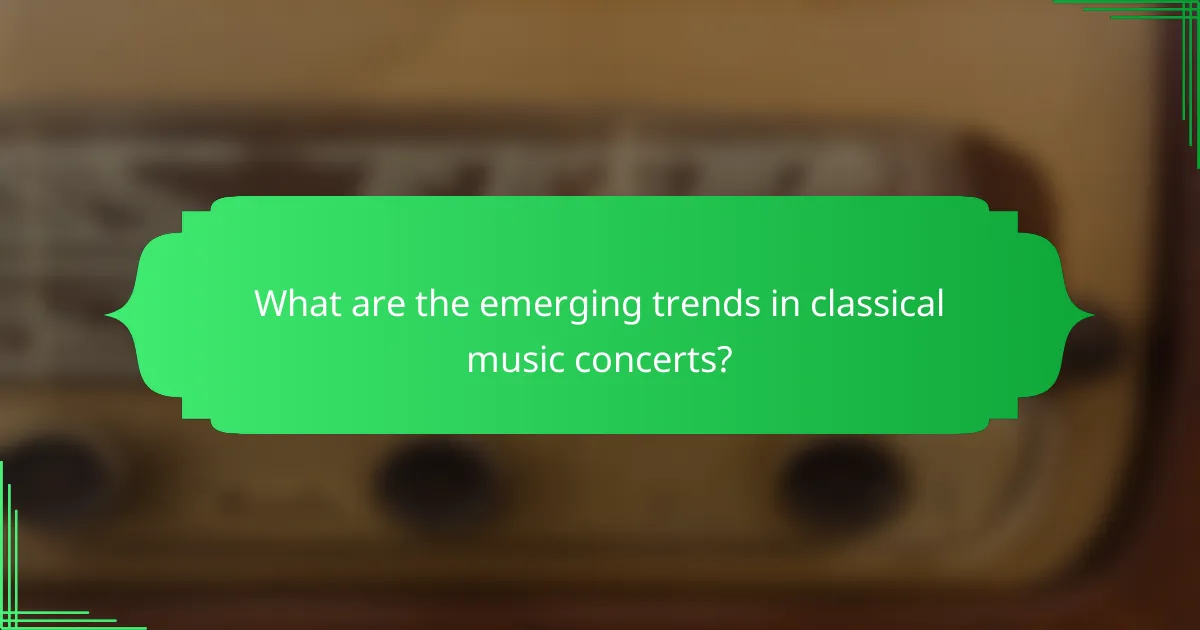
What are the emerging trends in classical music concerts?
Emerging trends in classical music concerts include innovative programming, enhanced audience engagement, and the integration of technology. These developments aim to attract diverse audiences and create more immersive experiences.
Orchestral dynamics
Orchestral dynamics refer to the varying levels of volume and intensity within a performance. Conductors play a crucial role in shaping these dynamics, guiding musicians to create contrasts that enhance emotional impact. For instance, a soft passage can evoke intimacy, while a powerful crescendo can generate excitement.
Modern orchestras are increasingly experimenting with dynamics by incorporating unconventional instruments or collaborating with different genres. This approach not only diversifies the sound but also attracts new listeners who may not typically attend classical concerts.
Conductor influence
The conductor significantly influences a performance’s interpretation and overall execution. Their gestures and cues guide the orchestra, ensuring cohesion and timing. A skilled conductor can transform a familiar piece into a fresh experience through unique interpretations and emphases.
Moreover, conductors are now more visible in the concert experience, often engaging with the audience before or after performances. This interaction helps demystify the music and fosters a deeper connection between the audience and the musicians.
Audience etiquette
Audience etiquette at classical concerts is evolving as venues strive to create a more welcoming atmosphere. Traditional norms, such as remaining silent during performances, are still important, but many venues now encourage audience members to express appreciation through applause at appropriate moments.
Additionally, some concerts are adopting relaxed formats, allowing for more casual attire and interactions. This shift aims to make classical music more accessible, particularly for younger audiences who may feel intimidated by traditional concert settings.
